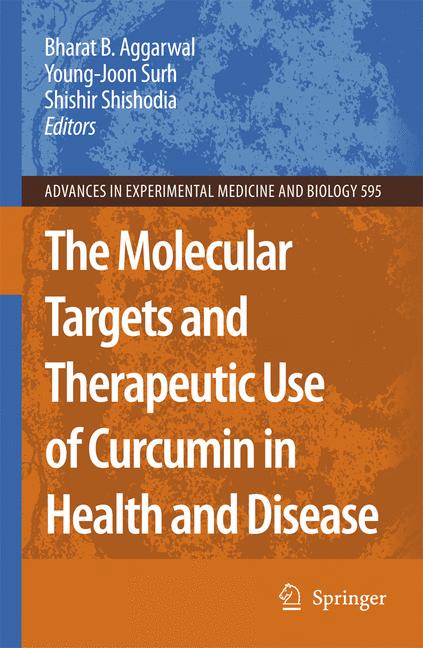| Chapter title |
Beneficial role of curcumin in skin diseases.
|
|---|---|
| Chapter number | 15 |
| Book title |
The Molecular Targets and Therapeutic Uses of Curcumin in Health and Disease
|
| Published in |
Advances in experimental medicine and biology, June 2007
|
| DOI | 10.1007/978-0-387-46401-5_15 |
| Pubmed ID | |
| Book ISBNs |
978-0-387-46400-8, 978-0-387-46401-5
|
| Authors |
Thangapazham RL, Sharma A, Maheshwari RK, Rajesh L. Thangapazham, Anuj Sharma, Radha K. Maheshwari, Thangapazham, Rajesh L., Sharma, Anuj, Maheshwari, Radha K. |
| Editors |
Bharat B. Aggarwal Ph.D., Young-Joon Surh Ph.D., Shishir Shishodia Ph.D. |
| Abstract |
In recent years, considerable interest has been focused on curcumin a compound, isolated from turmeric. Curcumin is used as a coloring, flavoring agent and has been traditionally used in medicine and cuisine in India. The varied biological properties of curcumin and lack of toxicity even when administered at higher doses makes it attractive to explore its use in various disorders like tumors of skin, colon, duodenum, pancreas, breast and other skin diseases. This chapter reviews the data on the use of curcumin for the chemoprevention and treatment of various skin diseases like scleroderma, psoriasis and skin cancer. Curcumin protects skin by quenching free radicals and reducing inflammation through nuclear factor-KB inhibition. Curcumin treatment also reduced wound-healing time, improved collagen deposition and increased fibroblast and vascular density in wounds thereby enhancing both normal and impaired wound-healing. Curcumin has also been shown to have beneficial effect as a proangiogenic agent in wound-healing by inducing transforming growth factor-beta, which induces both angiogenesis and accumulation of extracellular matrix, which continues through the remodeling phase of wound repair. These studies suggest the beneficial effects of curcumin and the potential of this compound to be developed as a potent nontoxic agent for treating skin diseases. |
X Demographics
Geographical breakdown
| Country | Count | As % |
|---|---|---|
| Unknown | 1 | 100% |
Demographic breakdown
| Type | Count | As % |
|---|---|---|
| Scientists | 1 | 100% |
Mendeley readers
Geographical breakdown
| Country | Count | As % |
|---|---|---|
| Indonesia | 1 | <1% |
| Italy | 1 | <1% |
| Unknown | 142 | 99% |
Demographic breakdown
| Readers by professional status | Count | As % |
|---|---|---|
| Student > Ph. D. Student | 23 | 16% |
| Student > Bachelor | 18 | 13% |
| Student > Master | 15 | 10% |
| Student > Doctoral Student | 9 | 6% |
| Researcher | 9 | 6% |
| Other | 20 | 14% |
| Unknown | 50 | 35% |
| Readers by discipline | Count | As % |
|---|---|---|
| Pharmacology, Toxicology and Pharmaceutical Science | 21 | 15% |
| Medicine and Dentistry | 18 | 13% |
| Agricultural and Biological Sciences | 14 | 10% |
| Biochemistry, Genetics and Molecular Biology | 14 | 10% |
| Nursing and Health Professions | 7 | 5% |
| Other | 18 | 13% |
| Unknown | 52 | 36% |
